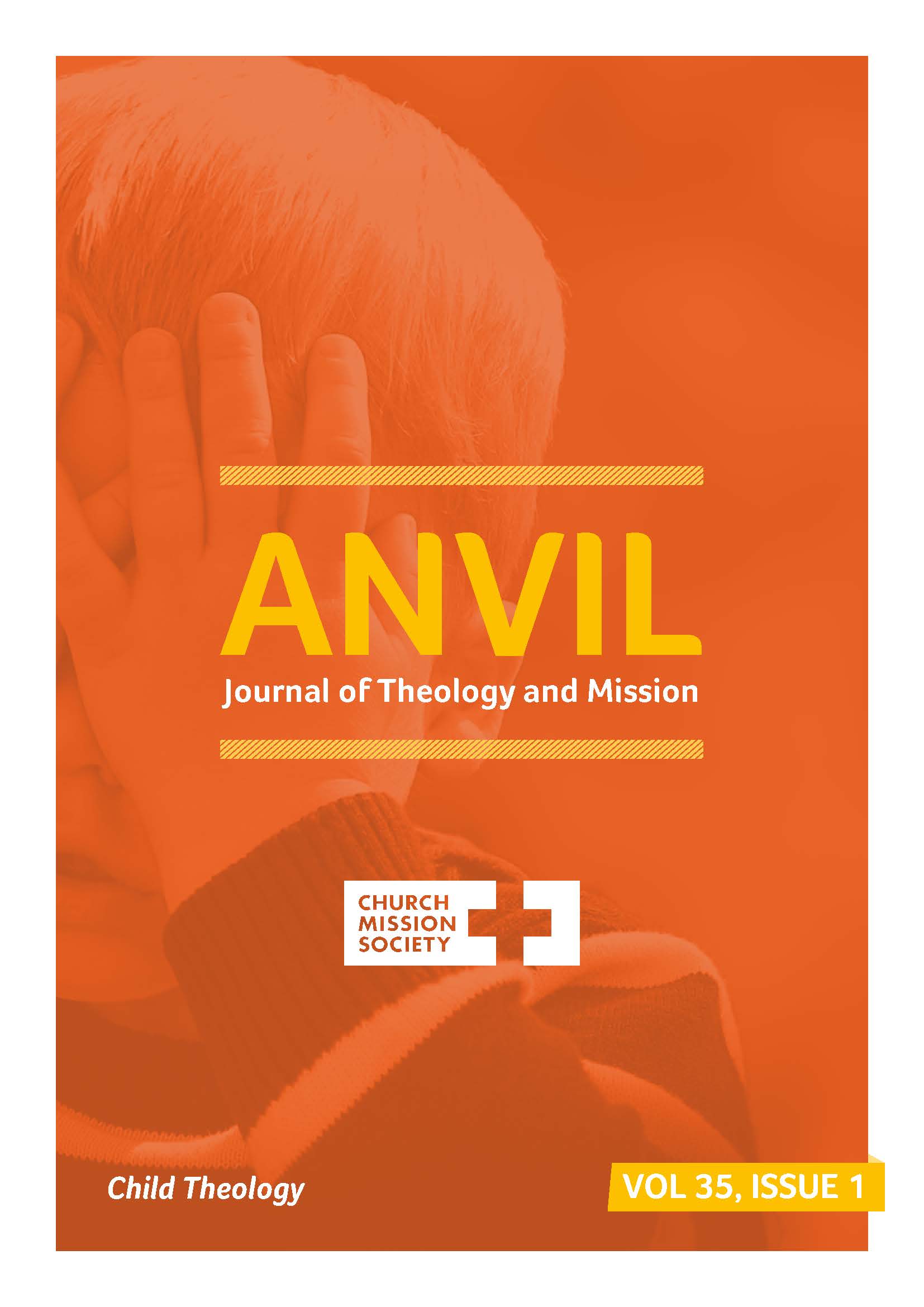ANVIL Journal of Theology and Mission

ANVIL Journal of Theology and Mission, Vol 35, Issue 1
ANVIL Journal of Theology and Mission
Doing theology with a child in the midst is at the heart of the Child Theology Movement (CTM www.childtheologymovement.org). We do theology this way in the hope that the theological reflection and engagement that comes from this can inform the mission and ministry of the whole church, not just work with children. This phrase is taken from Matthew 18:2 and reflects the action of Jesus in responding to his disciples question about who is the greatest in the Kingdom of heaven.
CTM evolved from international conferences about children at risk; reports of these conferences can be found on our website and give an understanding of the breadth and scope of the movement. Our key values are:
to be a global movement, culturally aware and sensitive;
to include and learn from minorities, the marginalised and the unempowered;
to follow Jesus in seeking the kingdom of God of which the child is a key sign, thus valuing the spiritual life of children without making them the focus of our activity;
to hold respectful dialogues with the Scriptures, current Christian theologies and the world; and to listen and to respond to others.
This special edition of Anvil includes both articles and case studies that reflect some of these values.
The first article is from Frances Young, Emeritus Professor of Theology at the University of Birmingham, and was the keynote address at a CTM conference on the future of child theology. It is written from the perspective of someone who is more of an outsider than an insider and discusses child theology in relation to other contextual theologies, its biblical foundation and its potential contribution to wider theological thinking in seeing child theology as a critical and visionary endeavour. There are some profound insights in this article offering what for some will be a fresh perspective on some key theological concepts.
The second article is from Keith White, who founded and currently chairs CTM and has been instrumental in ensuring that international material on child theology has been published. He leads Mill Grove, a residential Christian community established by his family in 1899. Keith's article starts with the approach taken in his book Entry Point 1(co-authored with Haddon Willmer) and discusses this in light of some of the common features of contextual theologies. He then looks at what is distinctive about the sort of theology he and Haddon engaged with in Entry Point, concluding that this sort of contextual theology was done from the perspective of having the Lord ever before them , and that is vital.
The third article is by DJ Konz, who teaches theology at Alphacrucis College in Australia. DJ explores the methodology of child theology as it stands, as well as suggesting developments for the future. Drawing on his doctoral studies, he argues for the use of the term child-attentive in relation to methodology and he illustrates this with his work on Karl Barth's theology. He does this with the intention of encouraging further approaches to studying child theology to emerge.
The final article is by Haddon Willmer, Emeritus Professor of Theology at the University of Leeds, and in it he seeks to identify resonances between his and Keith's book, Entry Point, and Frances Young's Arthur's Call, which is about her severely disabled son. Haddon grapples with the concept of reception and discusses Arthur's vocation in this light. He also discusses theodicy using some of Frances's searingly honest writing. This article challenges our disposition.
The first case study is from Ruth Radley, a CMS mission partner, and draws on her work in South Sudan training communities in children's rights. She talks about the importance of ensuring that leaders and parents understand the importance of both rights and responsibilities and that this is framed in the light of the well-being and flourishing of the children. The next case study is by Stuart Christine and gives an insight into his work as a BMS mission partner in South America, which was the focus of his PhD. He proposes that in deprived communities, the doorway to the Kingdom of God has the form of a child. Stuart uses stories of children in Luke's Gospel to reflect theologically on mission in the favelas. The third case study was written by Lucie Hutson, a children, family and contextual ministry specialist tutor at Midlands CYM, who introduces her concept of Muddy Church . Lucie talks about the connectedness with creation that we find in different parts of the biblical text and the significance of engaging with this intergenerationally. Such an approach can enhance well-being and help people to connect with God and each other in a meaningful way. She draws on play theory and the importance of allowing children to have agency and freedom and participate fully.
The final case study is from Paul Nash, who is the Chaplaincy and Spiritual Care Team Leader at Birmingham Women
and Children's Hospital. Paul
describes how the concept of putting a child in the midst helped a team of people working on a Christian series
of books for sick and dying children and bereaved siblings to identify the key truth that they wanted to
communicate. It is a practical example of how previous engagement with CTM changed and shaped his approach to
trying to do theology in his challenging context.
It has been a great privilege to edit this edition of Anvil on behalf of the Child Theology Movement and I am grateful for the opportunity for us to be able to disseminate the material in such a useful and accessible format.
The Revd Dr Sally Nash

